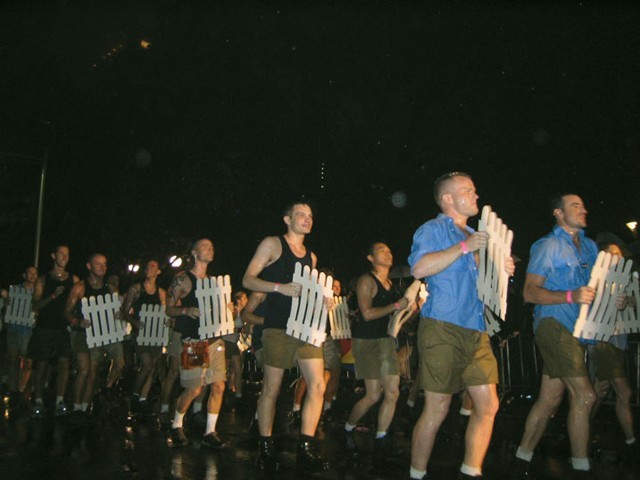AT the end of the High Court’s hearing on the ACT’s same sex marriage laws, a woman was looking for confirmation. “So that means it’s still on?”
“It” was the ceremony she had planned with her partner for this weekend in Canberra. The Chief Justice, Robert French, had just announced the court would hand down its ruling next Thursday, so the answer was yes.
Whether their union will last more than five days is another question entirely. The hearing didn’t even go the distance – it was slated for two days, but they were all done by 4.25 on Tuesday.
In many ways it put off the real battle on gay marriage; the one that will happen when a national government ultimately bows to public pressure and broadens the definition of marriage to include same-sex couples.
The Marriage Act of 1961 enshrined the common law idea of marriage, “the voluntary union for life of one man and one woman, to the exclusion of all others” in federal legislation. This came six decades after our founding fathers decided the commonwealth should have exclusive power to pass marriage laws.
There have been hints over the years that the High Court didn’t consider the definition of marriage to be set in stone. After all, the definition had sprung from an 1866 English case (Hyde v Hyde) in the matrimonial causes court.
The most recent of these came in 1999 when Justice Michael McHugh suggested “‘marriage’ now means, or in the near future may mean, a voluntary union for life between two people (his italics) to the exclusion of others”.
So when the Commonwealth Solicitor-General, Justin Gleeson SC, was offering that the act provided a single set of answers on marriage for all the states, Justice Ken Hayne couldn’t resist.
“A single set of answers with respect to Hyde v Hyde marriage or marriage more generally?” Hayne wanted to test the waters on the reach of the marriage power in the Constitution with a wary Gleeson: “You would expect it to be exercised, what, exhaustively?” he said. Gleeson promised he would get there later in his argument.
“Leave the time bomb just ticking there, Mr Solicitor.”
Gleeson didn’t want to answer the inevitable question; could the commonwealth legislate on same-sex unions under the marriage power? You can count on a Christian lobby group manning the barricades when that time comes.
However, Gleeson conceded that “on the better view” the Marriage Act could cover just about anything to do with marriage, from who you married to how you did it. Hayne was again on Gleeson’s case soon after Justice Susan Crennan suggested it was unthinkable in the 1900s “that a colour or a smell might be a trademark”.
“If you sit on the fence too long, Mr Solicitor, it becomes deeply uncomfortable.”
The counsel for Australians for Marriage Equality, Jeremy Kirk SC, was especially keen to point out the discomfort.
“It is not open to the commonwealth to remain on the fence,” Kirk said.
“The commonwealth’s case is that the Marriage Act provides implicitly that there can be no entry into that status other than under the commonwealth act.”
Hayne: “Whether or not the commonwealth wants to remain on the fence, what is your proposition about power? You assert the commonwealth has no power to enact a law for same-sex marriage, do you?”
Kirk: “No, no, to the contrary.”
Hayne: “I thought so.”
The consensus at the end of the day’s argument was that the court had punched more holes in the ACT’s case than the commonwealth’s, notwithstanding Gleeson’s occasional discomfort.
Kate Eastman, for the ACT, claimed the commonwealth had not covered the field on marriage; it had in fact “cleared the field” for others to legislate. The circularity of that argument was not lost on Justice Susan Kiefel.
Kiefel: “But the purpose of the ACT act is to give the same status to persons who are not described in the Marriage Act?
Eastman: “We would say . . . that what it offers a same-sex couple is to do something that they cannot do for the purpose of commonwealth law.”
Kiefel: “Which is acquire the status of marriage?”
When Eastman conceded they would not be recognised as married under commonwealth law, the court’s only gay justice, Virginia Bell, pointed out the obvious: “It gives a somewhat limited quality to equality.”
A big hurdle for the ACT is that under amendments to the Marriage Act in 2004 same-sex marriages entered into overseas are not recognised in Australia. More than one justice suggested that by “negative implication” the act had been an exhaustive statement of the law on the topic of the relationship of marriage.
AME says there are more than 1000 couples who have registered their interest in an ACT same-sex union. Just don’t call it marriage, for now. The fence isn’t that uncomfortable.
Author: Michael Pelly
Publication: The Australian
Date: 6 December 2013
Read original article here

